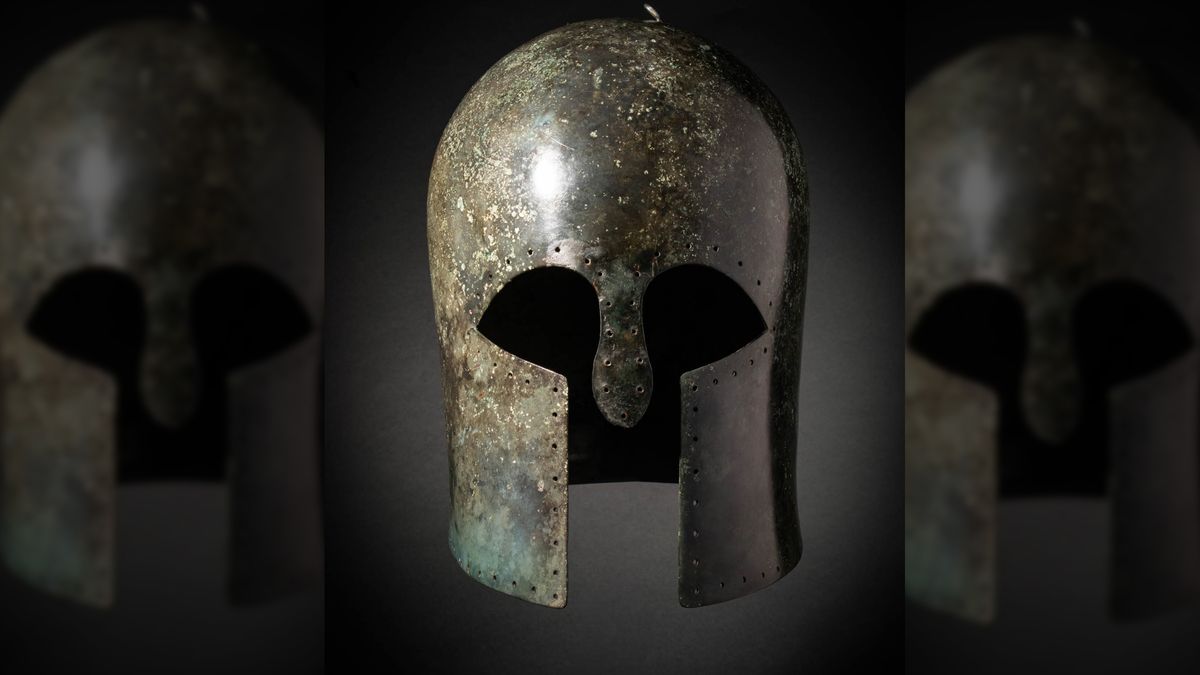A rare “Corinthian” helmet from ancient Greece will go up for auction in London later this month. Such helmets were iconic of the ancient Greek style of infantry fighting and have become emblems of the ancient world.
The Apollo Art Auctions company, which is auctioning the item, said the helmet is made from bronze and dates to between 500 and 450 B.C.
Helmets that cover most of the face like this, with only a gap for the eyes and mouth, are called Corinthian helmets, after the ancient Greek city-state of Corinth. The city was famous for both its culture and its warfare, but there is no clear evidence that this style was developed in Corinth. In fact, University of Cambridge archaeologist Anthony Snodgrass, in “Arms and Armor of the Greeks” (Johns Hopkins University Press, 1998) wrote that such helmets were used by warriors from many other ancient Greek city-states, including Sparta.
The object is “a rare and exceptionally well-preserved bronze Greek helmet, possibly linked to a Spartan warrior, offering a glimpse into the artistry and craftsmanship of ancient Greece,” Ivan Bonchev, director of Apollo Art Auctions, told Live Science in an email.
Related: 2,500-year-old Illyrian helmet found in burial mound likely caused ‘awe in the enemy’
Well-preserved Corinthian helmets are rare, but remnants of them have been found at many archaeological sites.
This one is expected to sell for between $72,000 and $108,000; it is being auctioned on behalf of a private collector, and the Art Loss Register has confirmed it is not stolen or missing, according to a statement on the auction site.
Ancient icon
Corinthian helmets had a long history in Greek warfare. In “Early Greek Armour And Weapons” (Edinburgh University Press, 1964) Snodgrass wrote that helmets of this style started to be used during the seventh century B.C., and that they were continuously developed in Greece until at least the fourth century B.C.
Many were decorated with crests made from horse hair, and some were inscribed or painted with geometric symbols. Greek art shows warriors wearing Corinthian helmets tilted back on the tops of their heads between battles, and the ancient Greek goddess Athena, the patron goddess of Athens, was commonly portrayed this way, even though Corinth and Athens were enemies during the Peloponnesian War between 431 and 404 B.C.
Helmets in war
Some later versions of Corinthian helmets had holes for the ears on each side, so that warriors wearing them could hear better. The helmet being sold in London this month has no such ear holes, but it has the distinctive eyeholes, noseguard and gap for the mouth of the Corinthian helmet.
Experts suggest Corinthian helmets limited the wearer’s peripheral vision, but that limitation may not have mattered in ancient Greek hoplite warfare, where warriors stood close together in a “phalanx” or block, with their shields and spears facing forward.
According to the Greek historian Piriklis Deligiannis, the Romans, for example, would have been familiar with Corinthian helmets from their contacts with Greek colonies in the south of the Italian Peninsula (which they called “Magna Graecia,” meaning “Greater Greece” in Latin.)
But the helmets used by Roman legionaries were based on Gallic helmets and had a relatively open face area without a noseguard, which may have made them more suitable for more varied Roman styles of infantry warfare.


